Analysis of the Spatiotemporal Evolution of Carbon Budget and Carbon Compensation Zoning in the Core Area of the Yangtze River Delta Urban Agglomeration
Abstract
:1. Introduction
2. Materials and Methods
2.1. Study Area
2.2. Data
2.3. Method
2.3.1. Calculation of Carbon Emissions
2.3.2. Calculation of Carbon Sink
2.3.3. Standard Deviation Ellipse Analysis
2.3.4. Spatial Autocorrelation Analysis
2.3.5. Calculation of Carbon Budget
2.3.6. Construction of Carbon Compensation Zoning Model
- (1)
- ECCwhere , represent the GDP of the ith county-level city and the whole region; , represent the carbon emissions of the ith county-level city and the whole region. The coefficient is used to measure the contribution of regional carbon emissions and the economy. When < 1, it means that the county-level city contributes more to carbon emissions than to the economy.
- (2)
- ESCwhere , represent the carbon sink of the ith county-level city and the whole region. This coefficient measures the region’s contribution to the carbon sink and carbon emissions. When > 1, it means that the county-level city contributes more to the carbon sink than to carbon emissions.
3. Results
3.1. Analysis of Spatiotemporal Distribution of Carbon Emissions
3.2. Analysis of Spatiotemporal Distribution of Carbon Sink
3.3. Analysis of the Spatiotemporal Distribution and Evolution of the Carbon Budget
3.4. Carbon Compensation Zoning Results and Overlay Analysis
3.4.1. Payment Zone
3.4.2. Balanced Zone
3.4.3. Compensated Zone
4. Discussion
5. Conclusions
Supplementary Materials
Author Contributions
Funding
Data Availability Statement
Conflicts of Interest
References
- Golledge, N.R.; Kowalewski, D.E.; Naish, T.R.; Levy, R.H.; Fogwill, C.J.; Gasson, E.G.W. The multi-millennial Antarctic commitment to future sea-level rise. Nature 2015, 526, 421–425. [Google Scholar] [CrossRef] [PubMed]
- Strauss, B.H.; Kulp, S.A.; Rasmussen, D.J.; Levermann, A. Unprecedented threats to cities from multi-century sea level rise. Environ. Res. Lett. 2021, 16, 114015. [Google Scholar] [CrossRef]
- Kharin, V.V.; Flato, G.M.; Zhang, X.; Gillett, N.P.; Zwiers, F.; Anderson, K.J. Risks from Climate Extremes Change Differently from 1.5 °C to 2.0 °C Depending on Rarity. Earths Future 2018, 6, 704–715. [Google Scholar] [CrossRef]
- Alfieri, L.; Bisselink, B.; Dottori, F.; Naumann, G.; de Roo, A.; Salamon, P.; Wyser, K.; Feyen, L. Global projections of river flood risk in a warmer world. Earths Future 2017, 5, 171–182. [Google Scholar] [CrossRef]
- Bender, M.A.; Knutson, T.R.; Tuleya, R.E.; Sirutis, J.J.; Vecchi, G.A.; Garner, S.T.; Held, I.M. Modeled Impact of Anthropogenic Warming on the Frequency of Intense Atlantic Hurricanes. Science 2010, 327, 454–458. [Google Scholar] [CrossRef]
- Zhang, W.X.; Zhou, T.J. Increasing impacts from extreme precipitation on population over China with global warming. Sci. Bull. 2020, 65, 243–252. [Google Scholar] [CrossRef] [PubMed]
- Jevrejeva, S.; Jackson, L.P.; Grinsted, A.; Lincke, D.; Marzeion, B. Flood damage costs under the sea level rise with warming of 1.5 °C and 2 °C. Environ. Res. Lett. 2018, 13, 074014. [Google Scholar] [CrossRef]
- Mohan, R.R. Time series GHG emission estimates for residential, commercial, agriculture and fisheries sectors in India. Atmos. Environ. 2018, 178, 73–79. [Google Scholar] [CrossRef]
- Bonetti, B.; Abruzzi, R.C.; Peglow, C.P.; Pires, M.J.R.; Gomes, C.J.B. CH4 and CO2 monitoring in the air of underground coal mines in southern Brazil and GHG emission estimation. REM—Int. Eng. J. 2019, 72, 635–642. [Google Scholar] [CrossRef]
- Ali, Y.; Pretaroli, R.; Socci, C.; Severini, F. Carbon and water footprint accounts of Italy: A Multi-Region Input-Output approach. Renew. Sust. Energ. Rev. 2018, 81, 1813–1824. [Google Scholar] [CrossRef]
- Sugarmansyah, U.; Setiastuti, N.; Apriyanto, H.; Mulyono, H.; Heldini, N.; Pradnyapasa, D.A.; Putera, I.P.; Medtry, M.; Putra, A.S.; Karim, S.; et al. The Impact of Export on the Development of Green Industries for Sustainability in DI Yogyakarta Region, Indonesia: An Extended Input-Output Analysis. Pol. J. Environ. Stud. 2024, 33, 1849–1860. [Google Scholar] [CrossRef]
- da Silva, M.G.; Muniz, A.R.C.; Hoffmann, R.; Lisbôa, A.C.L. Impact of greenhouse gases on surface coal mining in Brazil. J. Clean. Prod. 2018, 193, 206–216. [Google Scholar] [CrossRef]
- Rabani, M.; Madessa, H.B.; Ljungström, M.; Aamodt, L.; Lovvold, S.; Nord, N. Life cycle analysis of GHG emissions from the building retrofitting: The case of a Norwegian office building. Build. Environ. 2021, 204, 108159. [Google Scholar] [CrossRef]
- Parodi, A.; De Boer, I.J.M.; Gerrits, W.J.J.; Van Loon, J.J.A.; Heetkamp, M.J.W.; Van Schelt, J.; Bolhuis, J.E.; Van Zanten, H.H. Bioconversion efficiencies, greenhouse gas and ammonia emissions during black soldier fly rearing—A mass balance approach. J. Clean. Prod. 2020, 271, 122488. [Google Scholar] [CrossRef]
- Friedlingstein, P.; O’Sullivan, M.; Jones, M.W.; Andrew, R.M.; Hauck, J.; Olsen, A.; Peters, G.P.; Peters, W.; Pongratz, J.; Sitch, S.; et al. Global Carbon Budget 2020. Earth Syst. Sci. Data 2020, 12, 3269–3340. [Google Scholar] [CrossRef]
- Jandl, R.; Ledermann, T.; Kindermann, G.; Weiss, P. Soil Organic Carbon Stocks in Mixed-Deciduous and Coniferous Forests in Austria. Front. For. Glob. Change 2021, 4, 688851. [Google Scholar] [CrossRef]
- Cavaleri, M.A.; Coble, A.P.; Ryan, M.G.; Bauerle, W.L.; Loescher, H.W.; Oberbauer, S.F. Tropical rainforest carbon sink declines during EI Nino as a result of reduced photosynthesis and increased respiration rates. New Phytol. 2017, 216, 136–149. [Google Scholar] [CrossRef]
- Mao, F.J.; Zhou, G.M.; Li, P.H.; Du, H.Q.; Xu, X.J.; Shi, Y.J.; Mo, L.F.; Zhou, Y.F.; Tu, G.Q. Optimizing selective cutting strategies for maximum carbon stocks and yield of Moso bamboo forest using BIOME-BGC model. J. Environ. Manage. 2017, 191, 126–135. [Google Scholar] [CrossRef]
- Peylin, P.; Law, R.M.; Gurney, K.R.; Chevallier, F.; Jacobson, A.R.; Maki, T.; Niwa, Y.; Patra, P.K.; Peters, W.; Rayner, P.J.; et al. Global atmospheric carbon budget: Results from an ensemble of atmospheric CO2 inversions. Biogeosciences 2013, 10, 6699–6720. [Google Scholar] [CrossRef]
- Sleeter, B.M.; Liu, J.X.; Daniel, C.; Rayfield, B.; Sherba, J.; Hawbaker, T.J.; Zhu, Z.L.; Selmants, P.C.; Loveland, T.R. Effects of contemporary land-use and land-cover change on the carbon balance of terrestrial ecosystems in the United States. Environ. Res. Lett. 2018, 13, 045006. [Google Scholar] [CrossRef]
- Magerl, A.; Le Noë, J.; Erb, K.H.; Bhan, M.; Gingrich, S. A comprehensive data-based assessment of forest ecosystem carbon stocks in the US 1907-2012. Environ. Res. Lett. 2019, 14, 125015. [Google Scholar] [CrossRef]
- Hu, Y.B.; Zhang, Q.; Hu, S.J.; Xiao, G.J.; Zhang, L.; Han, L.Y.; Yue, P.; Wang, J.S.; Qi, Y.; Ye, P.L. Crop yield and carbon sink potential with precipitation in maize and potato cropland ecosystems over the summertime monsoon transition zone of China. Soil. Use Manag. 2023, 39, 742–756. [Google Scholar] [CrossRef]
- Ali, G.; Pumijumnong, N.; Cui, S.H. Valuation and validation of carbon sources and sinks through land cover/use change analysis: The case of Bangkok metropolitan area. Land Use Policy 2018, 70, 471–478. [Google Scholar] [CrossRef]
- Li, T.; Li, J.; Zhou, Z.X.; Wang, Y.Z.; Yang, X.N.; Qin, K.Y.; Liu, J.Y. Taking climate, land use, and social economy into estimation of carbon budget in the Guanzhong-Tianshui Economic Region of China. Environ. Sci. Pollut. Res. 2017, 24, 10466–10480. [Google Scholar] [CrossRef]
- Kim, D.; Lim, C.H.; Song, C.; Lee, W.K.; Piao, D.; Heo, S.; Jeon, S. Estimation of future carbon budget with climate change and reforestation scenario in North Korea. Adv. Space Res. 2016, 58, 1002–1016. [Google Scholar] [CrossRef]
- Oshiro, K.; Gi, K.; Fujimori, S.; van Soest, H.L.; Bertram, C.; Després, J.; Masui, T.; Rochedo, P.; Roelfsema, M.; Vrontisi, Z. Mid-century emission pathways in Japan associated with the global 2 °C goal: National and global models’ assessments based on carbon budgets. Clim. Change 2020, 162, 1913–1927. [Google Scholar] [CrossRef]
- Villalobos, Y.; Canadell, J.G.; Keller, E.D.; Briggs, P.R.; Bukosa, B.; Giltrap, D.L.; Harman, I.; Hilton, T.W.; Kirschbaum, M.U.F.; Lauerwald, R.; et al. A Comprehensive Assessment of Anthropogenic and Natural Sources and Sinks of Australasia’s Carbon Budget. Global Biogeochem. Cycles 2023, 37, e2023GB007845. [Google Scholar] [CrossRef]
- Pique, G.; Fieuzal, R.; Debaeke, P.; Al Bitar, A.; Tallec, T.; Ceschia, E. Combining High-Resolution Remote Sensing Products with a Crop Model to Estimate Carbon and Water Budget Components: Application to Sunflower. Remote Sens. 2020, 12, 2967. [Google Scholar] [CrossRef]
- Zhang, C.P.; Song, K.Y.; Wang, H.; Randhir, T.O. Carbon budget management in the civil aviation industry using an interactive control perspective. Int. J. Sustain. Transp. 2020, 15, 30–39. [Google Scholar] [CrossRef]
- Tamburini, E.; Turolla, E.; Lanzoni, M.; Moore, D.; Castaldelli, G. Manila clam and Mediterranean mussel aquaculture is sustainable and a net carbon sink. Sci. Total Environ. 2022, 848, 157508. [Google Scholar] [CrossRef]
- Lesiv, M.; Shvidenko, A.; Schepaschenko, D.; See, L.; Fritz, S. A spatial assessment of the forest carbon budget for Ukraine. Mitig. Adapt. Strateg. Glob. Chang. 2019, 24, 985–1006. [Google Scholar] [CrossRef]
- de la Motte, L.G.; Jérôme, E.; Mamadou, O.; Beckers, Y.; Bodson, B.; Heinesch, B.; Aubinet, M. Carbon balance of an intensively grazed permanent grassland in southern Belgium. Agric. For. Meteorol. 2016, 228, 370–383. [Google Scholar] [CrossRef]
- Zhao, R.Q.; Liu, Y.; Li, Y.X.; Ding, M.L.; Zhang, Z.P.; Chuai, X.W.; Jiao, S.X. Overview of Regional Carbon Compensation: Mechanism, Pattern and Policy Suggestions. Areal Res. Dev. 2015, 34, 116–120. (In Chinese) [Google Scholar]
- Li, D.L.; Cao, L.J.; Zhou, Z.H.; Zhao, K.K.; Du, Z.N.; Chen, Y.J. Correlating CO2 emissions of cities with the inter-city carbon compensation mechanism: A regional perspective in the middle reaches of the Yangtze River (MRYR), China. Environ. Dev. Sustain. 2023, 26, 9185–9216. [Google Scholar] [CrossRef]
- Wang, W.X.; Wang, W.J.; Xie, P.C.; Zhao, D.Q. Spatial and temporal disparities of carbon emissions and interregional carbon compensation in major function-oriented zones: A case study of Guangdong province. J. Clean. Prod. 2020, 245, 118873. [Google Scholar] [CrossRef]
- Chen, J.; Wu, S.S.; Zhang, L.F. Spatiotemporal Variation of Per Capita Carbon Emissions and Carbon Compensation Zoning in Chinese Counties. Land 2023, 12, 1796. [Google Scholar] [CrossRef]
- Gao, S.S.; Zhang, X.P.; Chen, M.X. Spatiotemporal dynamics and driving forces of city-level CO2 emissions in China from 2000 to 2019. J. Clean Prod. 2022, 377, 134358. [Google Scholar] [CrossRef]
- Miao, Y.; Kong, C.C.; Wang, L.L.; Mu, J.Z.; Lu, X.; Bao, J.Q.; Li, H. A provincial lateral carbon emissions compensation plan in China based on carbon budget perspective. Sci. Total Environ. 2019, 692, 1086–1096. [Google Scholar] [CrossRef] [PubMed]
- Zhou, L.; Song, J.; Chi, Y.G.; Yu, Q.Z. Differential Spatiotemporal Patterns of CO2 Emissions in Eastern China’s Urban Agglomerations from NPP/VIIRS Nighttime Light Data Based on a Neural Network Algorithm. Remote Sens. 2023, 15, 404. [Google Scholar] [CrossRef]
- Han, J.; Meng, X.; Zhou, X.; Yi, B.L.; Liu, M.; Xiang, W.N. A long-term analysis of urbanization process, landscape change, and carbon sources and sinks: A case study in China’s Yangtze River Delta region. J. Clean. Prod. 2017, 141, 1040–1050. [Google Scholar] [CrossRef]
- Zhu, S.Y.; Ding, Y.; Pan, R.; Ding, A.F. Analysis of Interprovincial Differences in CO2 Emissions and Peak Prediction in the Yangtze River Delta. Sustainability 2023, 15, 6474. [Google Scholar] [CrossRef]
- Doll, C.N.H.; Muller, J.P.; Elvidge, C.D. Night-time imagery as a tool for global mapping of socioeconomic parameters and greenhouse gas emissions. Ambio 2000, 29, 157–162. [Google Scholar] [CrossRef]
- Elvidge, C.D.; Imhoff, M.L.; Baugh, K.E.; Hobson, V.R.; Nelson, I.; Safran, J.; Dietz, J.B.; Tuttle, B.T. Night-time lights of the world: 1994–1995. ISPRS-J. Photogramm. Remote Sens. 2001, 56, 81–99. [Google Scholar] [CrossRef]
- Meng, L.N.; Graus, W.; Worrell, E.; Huang, B. Estimating CO2 (carbon dioxide) emissions at urban scales by DMSP/OLS (Defense Meteorological Satellite Program’s Operational Linescan System) nighttime light imagery: Methodological challenges and a case study for China. Energy 2014, 71, 468–478. [Google Scholar] [CrossRef]
- Xu, J.H.; Li, Y.Y.; Hu, F.; Wang, L.; Wang, K.; Ma, W.H.; Ruan, N.; Jiang, W.Z. Spatio-Temporal Variation of Carbon Emission Intensity and Spatial Heterogeneity of Influencing Factors in the Yangtze River Delta. Atmosphere 2023, 14, 163. [Google Scholar] [CrossRef]
- Li, W.; Chen, Z.J.; Li, M.C.; Zhang, H.; Li, M.Y.; Qiu, X.Q.; Zhou, C. Carbon emission and economic development trade-offs for optimizing land-use allocation in the Yangtze River Delta, China. Ecol. Indic. 2023, 147, 109950. [Google Scholar] [CrossRef]
- Doumbia, E.T.; Liousse, C.; Keita, S.; Granier, L.; Granier, C.; Elvidge, C.D.; Elguindi, N.; Law, K. Flaring emissions in Africa: Distribution, evolution and comparison with current inventories. Atmos. Environ. 2019, 199, 423–434. [Google Scholar] [CrossRef]
- Su, Y.X.; Chen, X.Z.; Li, Y.; Liao, J.S.; Ye, Y.Y.; Zhang, H.G.; Huang, N.S.; Kuang, Y.Q. China’s 19-year city-level carbon emissions of energy consumptions, driving forces and regionalized mitigation guidelines. Renew. Sust. Energ. Rev. 2014, 35, 231–243. [Google Scholar] [CrossRef]
- Lv, Q.; Liu, H.B.; Wang, J.T.; Liu, H.; Shang, Y. Multiscale analysis on spatiotemporal dynamics of energy consumption CO2 emissions in China: Utilizing the integrated of DMSP-OLS and NPP-VIIRS nighttime light datasets. Sci. Total Environ. 2020, 703, 134394. [Google Scholar] [CrossRef]
- Li, X.; Li, D.R.; Xu, H.M.; Wu, C.Q. Intercalibration between DMSP/OLS and VIIRS night-time light images to evaluate city light dynamics of Syria’s major human settlement during Syrian Civil War. Int. J. Remote Sens. 2017, 38, 5934–5951. [Google Scholar] [CrossRef]
- Wei, W.; Du, H.B.; Ma, L.B.; Liu, C.F.; Zhou, J.J. Spatiotemporal dynamics of CO2 emissions using nighttime light data: A comparative analysis between the Yellow and Yangtze River Basins in China. Environ. Dev. Sustain. 2024, 26, 1081–1102. [Google Scholar] [CrossRef]
- Zhu, Z.; Yu, J.Y.; Luo, J.H.; Zhang, H.Y.; Wu, Q.L.; Chen, Y.H. A GDM-GTWR-Coupled Model for Spatiotemporal Heterogeneity Quantification of CO2 Emissions: A Case of the Yangtze River Delta Urban Agglomeration from 2000 to 2017. Atmosphere 2022, 13, 1195. [Google Scholar] [CrossRef]
- Xu, G.; Zeng, T.Y.; Jin, H.; Xu, C.; Zhang, Z.Q. Spatio-Temporal Variations and Influencing Factors of Country-Level Carbon Emissions for Northeast China Based on VIIRS Nighttime Lighting Data. Int. J. Environ. Res. Public. Health 2023, 20, 829. [Google Scholar] [CrossRef] [PubMed]
- Sun, W.; Wu, R.H. Study on the balance of carbon budget and its spatial differentiation in Yangtze River Delta. Geogr. Res. 2012, 31, 2220–2228. (In Chinese) [Google Scholar]
- Yang, J.; Huang, X. The 30 m annual land cover dataset and its dynamics in China from 1990 to 2019. Earth Syst. Sci. Data 2021, 13, 3907–3925. [Google Scholar] [CrossRef]
- Huang, M.; Ji, J.J.; Cao, M.K.; Li, K.R. Modeling study of vegetation shoot and root biomass in China. Acta Ecol. Sin. 2006, 26, 4156–4163. (In Chinese) [Google Scholar]
- Wang, R.; Ci, H.; Zhang, T.; Tang, Y.X.; Wei, J.Y.; Yang, H.; Feng, G.F.; Yan, Z.J. Spatial-Temporal Evolution Characteristics of Industrial Carbon Emissions in China’s Most Developed Provinces from 1998-2013: The Case of Guangdong. Energies 2023, 16, 2249. [Google Scholar] [CrossRef]
- Xia, S.Y.; Yang, Y. Examining spatio-temporal variations in carbon budget and carbon compensation zoning in Beijing-Tianjin-Hebei urban agglomeration based on major functional zones. J. Geog. Sci. 2022, 32, 1911–1934. [Google Scholar] [CrossRef]
- Wei, Z.Y.; Li, J.M.; Wang, Z.Y.; Zhou, A.Q.; Li, M.H. County carbon emissions in the Yangtze River Delta region: Spatial layout, dynamic evolution and spatial spillover effects. Front. Environ. Sci. 2022, 10, 977198. [Google Scholar] [CrossRef]
- Yi, B.L.; Han, J.; Zhou, X.; Yang, F.; Meng, X.; Cao, W.X.; Huang, L.X.; Xiang, W.N. Spatiotemporal pattern of carbon sources and sinks in Yangtze River Delta region, China. Chin. J. Appl. Ecol. 2015, 26, 973–980. (In Chinese) [Google Scholar]
- Luo, Z.H.; Wu, Y.Y.; Zhou, L.X.; Sun, Q.; Yu, X.J.; Zhu, L.P.; Zhang, X.J.; Fang, Q.L.; Yang, X.; Yang, J.; et al. Trade-off between vegetation CO2 sequestration and fossil fuel-related CO2 emissions: A case study of the Guangdong-Hong Kong-Macao Greater Bay Area of China. Sust. Cities Soc. 2021, 74, 103195. [Google Scholar] [CrossRef]
- Chai, Y.; Lin, X.Q.; Wang, D. Industrial Structure Transformation and Layout Optimization of Beijing-Tianjin-Hebei Region under Carbon Emission Constraints. Sustainability 2021, 13, 643. [Google Scholar] [CrossRef]
- Zheng, R.J.; Cheng, Y.; Liu, H.M.; Chen, W.; Chen, X.D.; Wang, Y.P. The Spatiotemporal Distribution and Drivers of Urban Carbon Emission Efficiency: The Role of Technological Innovation. Int. J. Environ. Res. Public. Health 2022, 19, 9111. [Google Scholar] [CrossRef]
- Xiong, S.W.; Yang, F.; Li, J.Y.; Xu, Z.N.; Ou, J.G. Temporal-spatial variation and regulatory mechanism of carbon budgets in territorial space through the lens of carbon balance: A case of the middle reaches of the Yangtze River urban agglomerations, China. Ecol. Indic. 2023, 154, 110885. [Google Scholar] [CrossRef]
- Ye, C.; Zhu, J.J.; Li, S.M.; Yang, S.; Chen, M.X. Assessment and analysis of regional economic collaborative development within an urban agglomeration: Yangtze River Delta as a case study. Habitat Int. 2019, 83, 20–29. [Google Scholar] [CrossRef]
- Zhu, K.; Sun, W.X. Collaborative agglomeration level and spatial correlation of intercity manufacturing industry: An empirical study based on the cities of the Yangtze River Delta. PLoS ONE 2023, 18, e0293645. [Google Scholar] [CrossRef] [PubMed]
- Zhang, P.L.; Li, H.L.; Wang, J.Q.; Hong, J.W. Analysis of Spatial Wharf Pattern of the Yangtze River Delta Urban Agglomeration, China. Isprs Int. J. Geo-Inf. 2019, 8, 541. [Google Scholar] [CrossRef]
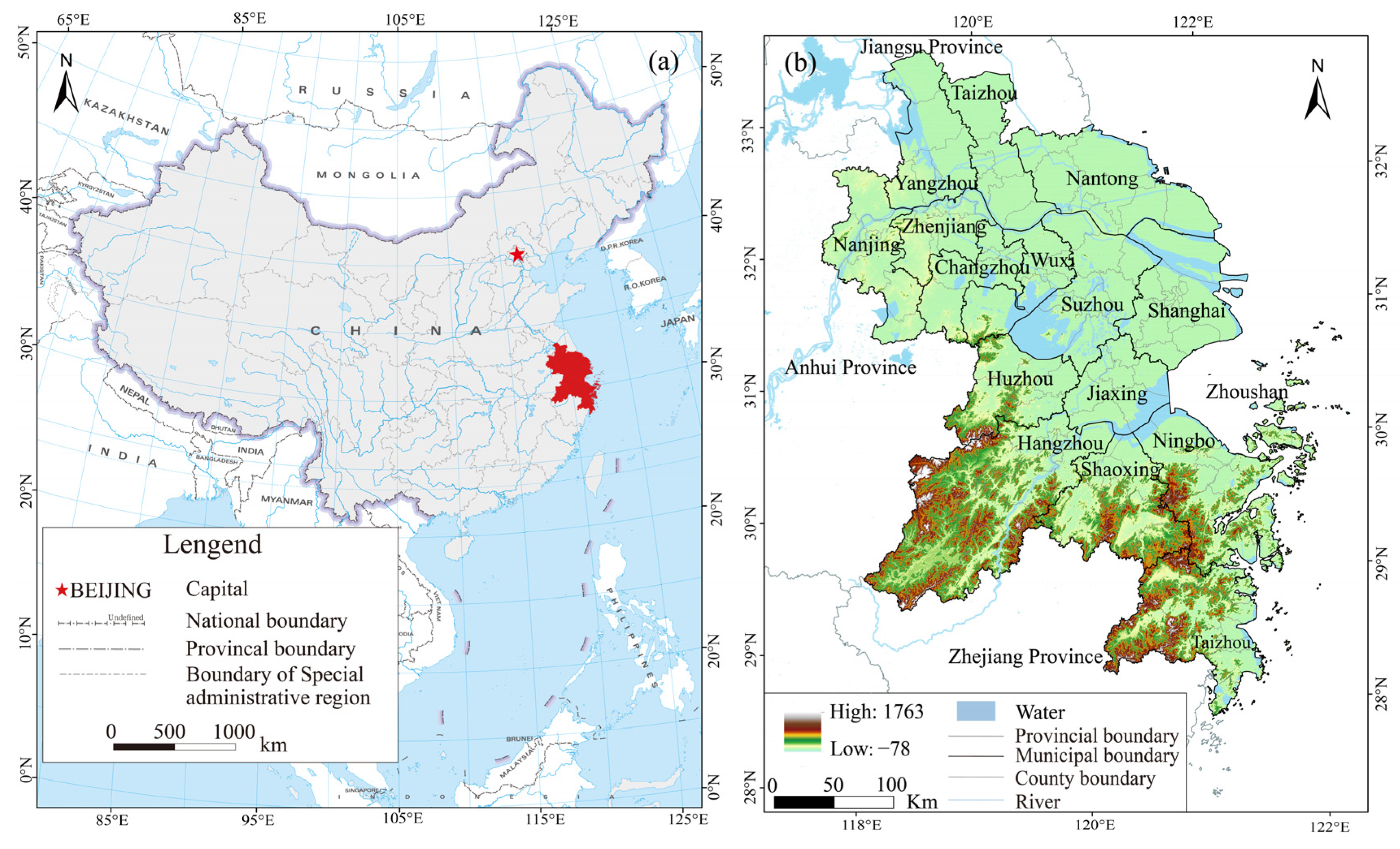
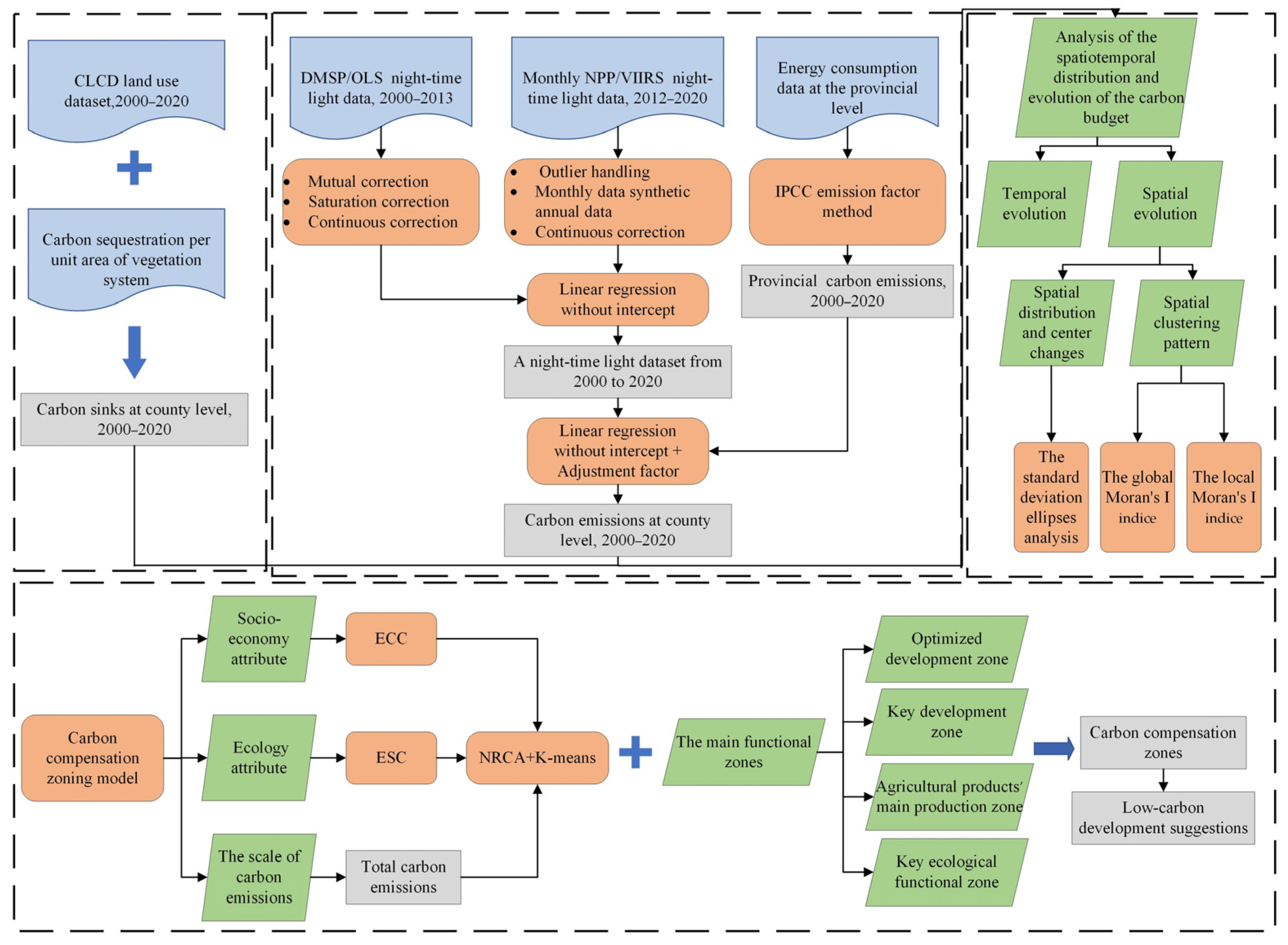

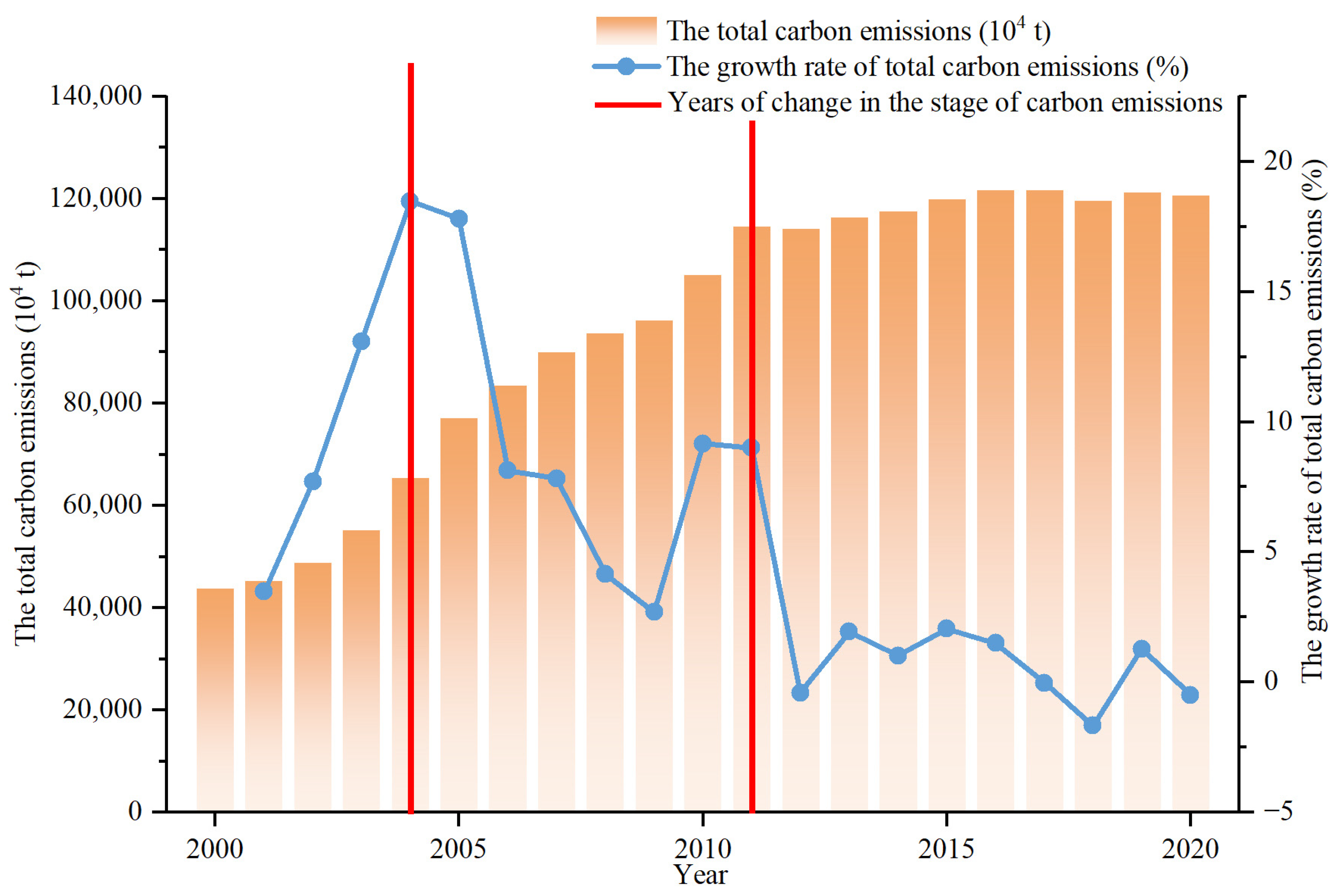



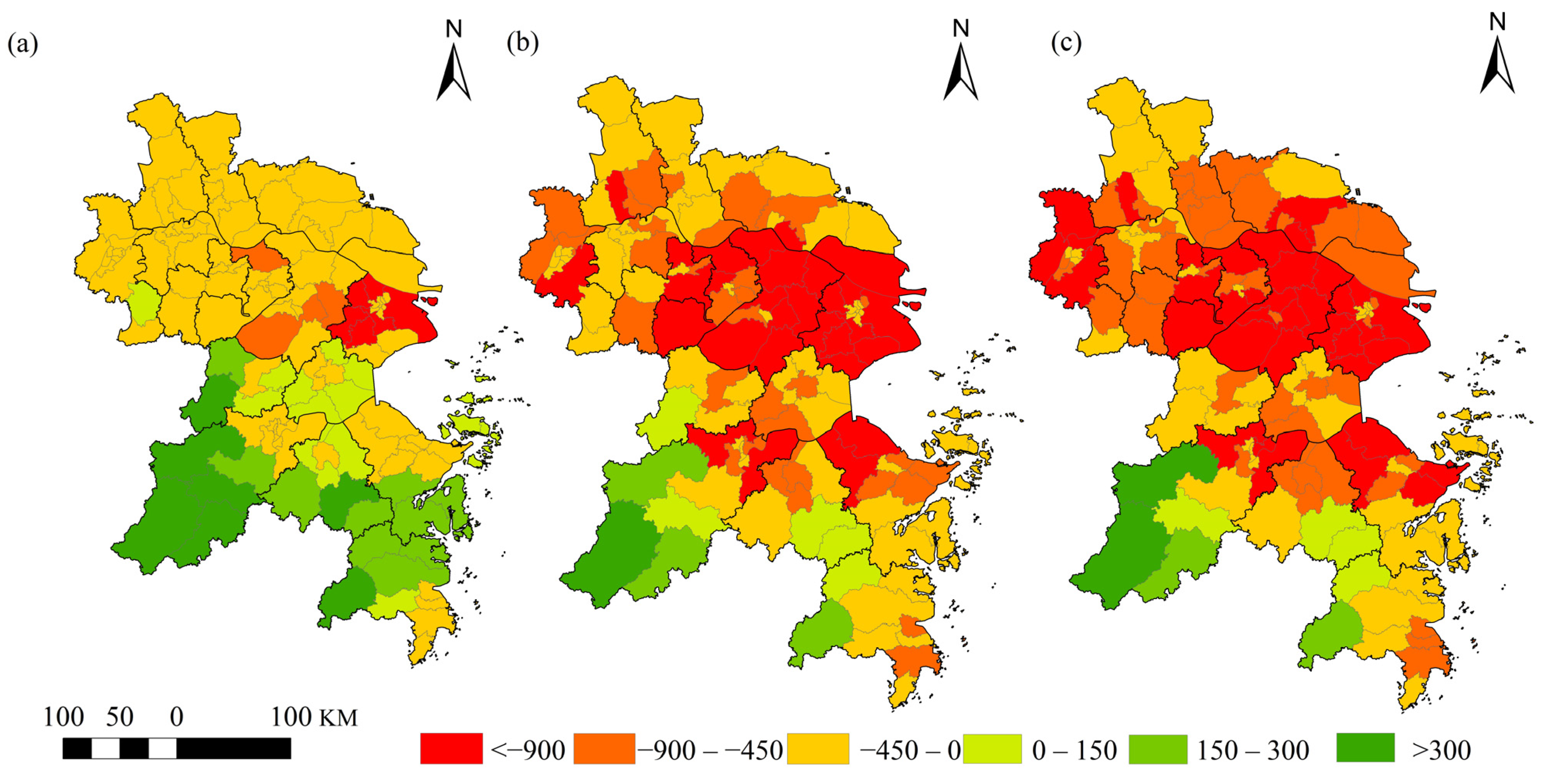


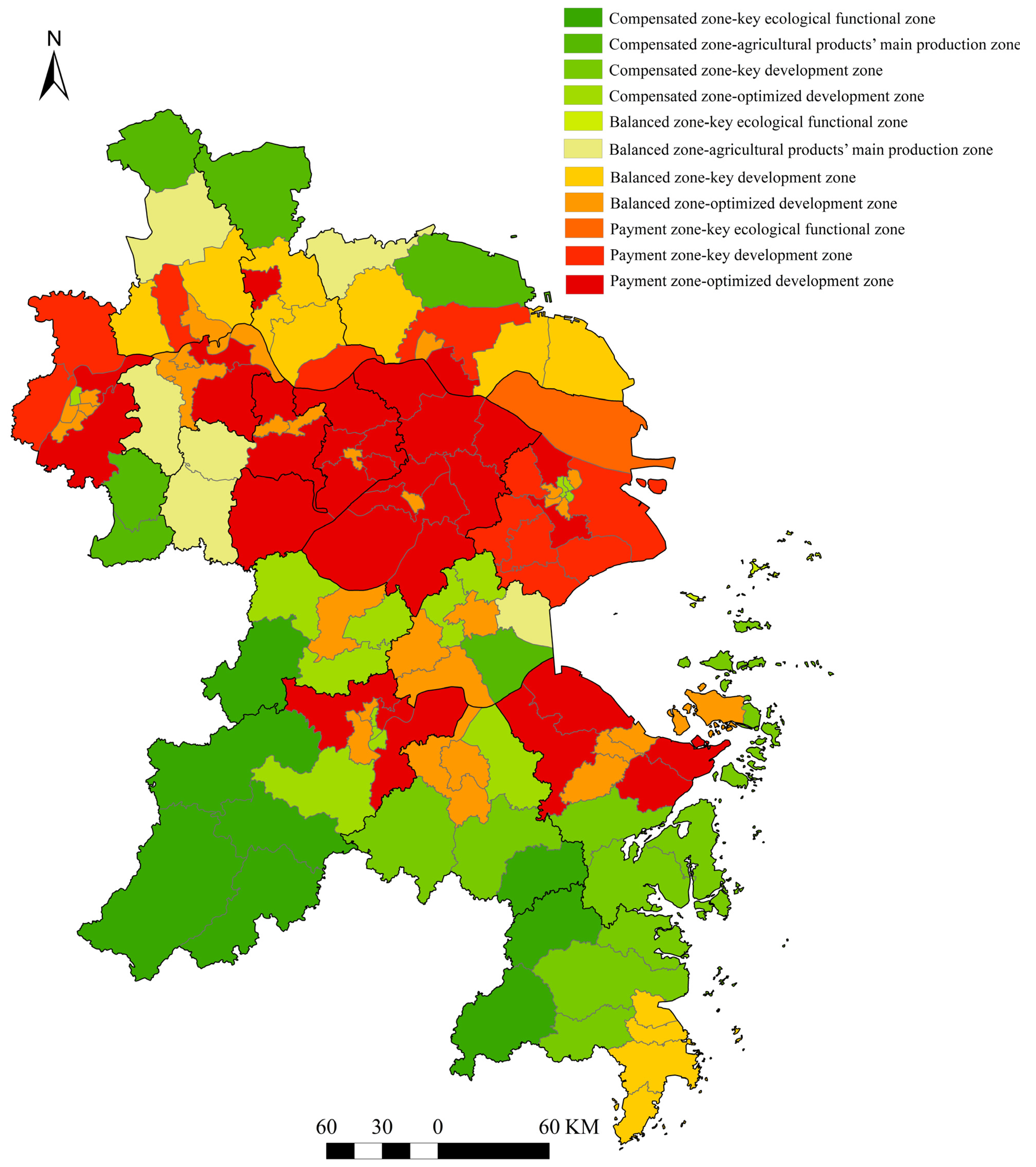
| Energy Type | Raw Coal | Coke | Crude Oil | Gasoline | Kerosene | Diesel Oil | Fuel Oil | Natural Gas |
|---|---|---|---|---|---|---|---|---|
| Percentage of usage | 67.14% | 6.70% | 13.45% | 3.17% | 0.96% | 3.64% | 2.22% | 2.72% |
| SCE conversion factor (tSCE/t) | 0.7143 | 0.9714 | 1.4286 | 1.4714 | 1.4714 | 1.4571 | 1.4286 | 1.33 |
| CO2 factor (104 tC/104 tSCE) | 0.7559 | 0.855 | 0.5857 | 0.5538 | 0.5714 | 0.5921 | 0.6185 | 0.4483 |
| Years | Provincial Administrative Divisions | A | R2 |
|---|---|---|---|
| 2000–2004 | Jiangsu, Zhejiang | 0.0188 | 0.9123 |
| 2000–2004 | Shanghai | 0.0341 | 0.8776 |
| 2005–2009 | Jiangsu, Zhejiang, Shanghai | 0.0243 | 0.9076 |
| 2010–2014 | Jiangsu, Zhejiang, Shanghai | 0.0245 | 0.9299 |
| 2015–2016 | Jiangsu, Zhejiang, Shanghai | 0.0216 | 0.9446 |
| 2017–2018 | Jiangsu, Zhejiang, Shanghai | 0.019 | 0.9191 |
| 2019–2020 | Jiangsu, Zhejiang, Shanghai | 0.0171 | 0.9326 |
| Provincial Administrative Divisions | Forestland | Grassland | Cropland |
|---|---|---|---|
| Shanghai | 13.39 | 13.50 | 13.01 |
| Jiangsu | 4.17 | 3.23 | 3.86 |
| Zhejiang | 5.44 | 8.47 | 9.41 |
| Vegetation Types | Root–Top Ratio |
|---|---|
| Forest | 0.17–0.36 |
| Cropland | 0.19 |
| Grassland | 5.2 |
| Year | Moran’s I | Z-Score | p-Value |
|---|---|---|---|
| 2000 | 0.32 | 7.30 | <0.01 |
| 2005 | 0.21 | 4.62 | <0.01 |
| 2010 | 0.16 | 3.39 | <0.01 |
| 2015 | 0.12 | 2.70 | <0.01 |
| 2020 | 0.09 | 2.04 | <0.05 |
| Carbon Compensation Zones (Number of Units) | GDP (%) | Carbon Emissions (%) | Carbon Sink (%) | Land Area (%) |
|---|---|---|---|---|
| Payment zone—optimized development zone (31) | 37.07% | 43.42% | 15.19% | 23.42% |
| Payment zone—key development zone (11) | 16.38% | 19.01% | 10.07% | 8.51% |
| Payment zone—key ecological functional zone (1) | 0.24% | 1.27% | 3.45% | 2.09% |
| Balanced zone—optimized development zone (29) | 17.60% | 13.48% | 8.36% | 7.89% |
| Balanced zone—key development zone (12) | 7.09% | 6.73% | 7.63% | 9.40% |
| Balanced zone—agricultural products’ main production zone (6) | 3.18% | 3.34% | 4.94% | 6.80% |
| Balanced zone—key ecological functional zone (1) | 0.07% | 0.10% | 0.05% | 0.04% |
| Compensated zones—optimized development zone (14) | 9.76% | 4.44% | 9.24% | 6.72% |
| Compensated zones—key development zone (10) | 3.73% | 3.58% | 15.13% | 11.38% |
| Compensated zones—agricultural products’ main production zone (6) | 2.93% | 2.53% | 5.38% | 7.67% |
| Compensated zones—key ecological functional zone (8) | 1.95% | 2.10% | 20.56% | 16.08% |
Disclaimer/Publisher’s Note: The statements, opinions and data contained in all publications are solely those of the individual author(s) and contributor(s) and not of MDPI and/or the editor(s). MDPI and/or the editor(s) disclaim responsibility for any injury to people or property resulting from any ideas, methods, instructions or products referred to in the content. |
© 2024 by the authors. Licensee MDPI, Basel, Switzerland. This article is an open access article distributed under the terms and conditions of the Creative Commons Attribution (CC BY) license (https://creativecommons.org/licenses/by/4.0/).
Share and Cite
Tang, Y.; Wang, R.; Ci, H.; Wei, J.; Yang, H.; Teng, J.; Yan, Z. Analysis of the Spatiotemporal Evolution of Carbon Budget and Carbon Compensation Zoning in the Core Area of the Yangtze River Delta Urban Agglomeration. Land 2024, 13, 747. https://doi.org/10.3390/land13060747
Tang Y, Wang R, Ci H, Wei J, Yang H, Teng J, Yan Z. Analysis of the Spatiotemporal Evolution of Carbon Budget and Carbon Compensation Zoning in the Core Area of the Yangtze River Delta Urban Agglomeration. Land. 2024; 13(6):747. https://doi.org/10.3390/land13060747
Chicago/Turabian StyleTang, Yuxin, Ran Wang, Hui Ci, Jinyuan Wei, Hui Yang, Jiakun Teng, and Zhaojin Yan. 2024. "Analysis of the Spatiotemporal Evolution of Carbon Budget and Carbon Compensation Zoning in the Core Area of the Yangtze River Delta Urban Agglomeration" Land 13, no. 6: 747. https://doi.org/10.3390/land13060747





